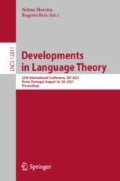Abstract
We define a new quantitative measure for an arbitrary factorial language: the entropy of a random walk in the prefix tree associated with the language; we call it Markov entropy. We relate Markov entropy to the growth rate of the language and the parameters of branching of its prefix tree. We show how to compute Markov entropy for a regular language. Finally, we develop a framework for experimental study of Markov entropy by modelling random walks and present the results of experiments with power-free and Abelian-power-free languages.
Supported by the Ministry of Science and Higher Education of the Russian Federation (Ural Mathematical Center project No. 075-02-2021-1387).
Access this chapter
Tax calculation will be finalised at checkout
Purchases are for personal use only
Notes
- 1.
Non-uniform distributions are also used in many applications but we do not consider them here.
- 2.
Note that it is not possible in general to find the roots of polynomials exactly.
References
Aberkane, A., Currie, J.D., Rampersad, N.: The number of ternary words avoiding abelian cubes grows exponentially. J. Integer Seq. 7(2) (2004)
Carpi, A.: On the number of Abelian square-free words on four letters. Discrete Appl. Math. 81, 155–167 (1998)
Carpi, A.: On Dejean’s conjecture over large alphabets. Theor. Comput. Sci. 385, 137–151 (1999)
Crochemore, M., Mignosi, F., Restivo, A., Salemi, S.: Data compression using antidictionaries. Proc. IEEE 88(11), 1756–1768 (2000)
Currie, J.D.: The number of binary words avoiding abelian fourth powers grows exponentially. Theor. Comput. Sci. 319, 441–446 (2004)
Currie, J.D., Rampersad, N.: A proof of Dejean’s conjecture. Math. Comp. 80, 1063–1070 (2011)
Dejean, F.: Sur un théorème de Thue. J. Combin. Theor. Ser. A 13, 90–99 (1972)
Dekking, F.M.: Strongly non-repetitive sequences and progression-free sets. J. Combin. Theory. Ser. A 27, 181–185 (1979)
Fekete, M.: Über der Verteilung der Wurzeln bei gewissen algebraischen Gleichungen mit ganzzahligen Koeffizienten. Math. Zeitschrift 17, 228–249 (1923)
Furstenberg, H.: Disjointness in ergodic theory, minimal sets, and a problem in diophantine approximation. Math. Syst. Theor. 1, 1–49 (1967)
Grinstead, C.M., Snell, J.L.: Introduction to Probability. American Mathematical Society, Providence (1997)
Keränen, V.: Abelian squares are avoidable on 4 letters. In: Kuich, W. (ed.) ICALP 1992. LNCS, vol. 623, pp. 41–52. Springer, Heidelberg (1992). https://doi.org/10.1007/3-540-55719-9_62
Kolpakov, R., Rao, M.: On the number of Dejean words over alphabets of 5, 6, 7, 8, 9 and 10 letters. Theor. Comput. Sci. 412, 6507–6516 (2011)
Kosolobov, D.: Online detection of repetitions with backtracking. In: Cicalese, F., Porat, E., Vaccaro, U. (eds.) CPM 2015. LNCS, vol. 9133, pp. 295–306. Springer, Cham (2015). https://doi.org/10.1007/978-3-319-19929-0_25
Lyons, R., Peres, Y.: Probability on Trees and Networks, Cambridge Series in Statistical and Probabilistic Mathematics, vol. 42. Cambridge University Press, New York (2016)
Mohammad-Noori, M., Currie, J.D.: Dejean’s conjecture and Sturmian words. Eur. J. Comb. 28, 876–890 (2007)
Moulin-Ollagnier, J.: Proof of Dejean’s conjecture for alphabets with \(5,6,7,8,9,10\) and \(11\) letters. Theor. Comput. Sci. 95, 187–205 (1992)
Pansiot, J.J.: A propos d’une conjecture de F. Dejean sur les répétitions dans les mots. Discrete Appl. Math. 7, 297–311 (1984)
Petrova, E.A., Shur, A.M.: Branching densities of cube-free and square-free words. Algorithms 14(4), 126 (2021)
Rao, M.: Last cases of Dejean’s conjecture. Theor. Comput. Sci. 412, 3010–3018 (2011)
Rissanen, J.J.: Generalized Kraft inequality and arithmetic coding. IBM J. Res. Dev. 20, 198–203 (1976)
Samsonov, A.V., Shur, A.M.: On Abelian repetition threshold. RAIRO Theor. Inf. Appl. 46, 147–163 (2012)
Shannon, C.E.: A mathematical theory of communication. Bell Syst. Tech. J. 27(379–423), 623–656 (1948)
Shur, A.M.: Combinatorial complexity of regular languages. In: Hirsch, E.A., Razborov, A.A., Semenov, A., Slissenko, A. (eds.) CSR 2008. LNCS, vol. 5010, pp. 289–301. Springer, Heidelberg (2008). https://doi.org/10.1007/978-3-540-79709-8_30
Shur, A.M.: Two-sided bounds for the growth rates of power-free languages. In: Diekert, V., Nowotka, D. (eds.) DLT 2009. LNCS, vol. 5583, pp. 466–477. Springer, Heidelberg (2009). https://doi.org/10.1007/978-3-642-02737-6_38
Shur, A.M.: Growth rates of complexity of power-free languages. Theor. Comput. Sci. 411, 3209–3223 (2010)
Shur, A.M.: Growth properties of power-free languages. Comput. Sci. Rev. 6, 187–208 (2012)
Shur, A.M., Gorbunova, I.A.: On the growth rates of complexity of threshold languages. RAIRO Theor. Inf. Appl. 44, 175–192 (2010)
Markov entropy of repetition-free languages–statistics (2021). https://tinyurl.com/2j36b6j7
Author information
Authors and Affiliations
Corresponding author
Editor information
Editors and Affiliations
Rights and permissions
Copyright information
© 2021 Springer Nature Switzerland AG
About this paper
Cite this paper
Petrova, E.A., Shur, A.M. (2021). Branching Frequency and Markov Entropy of Repetition-Free Languages. In: Moreira, N., Reis, R. (eds) Developments in Language Theory. DLT 2021. Lecture Notes in Computer Science(), vol 12811. Springer, Cham. https://doi.org/10.1007/978-3-030-81508-0_27
Download citation
DOI: https://doi.org/10.1007/978-3-030-81508-0_27
Published:
Publisher Name: Springer, Cham
Print ISBN: 978-3-030-81507-3
Online ISBN: 978-3-030-81508-0
eBook Packages: Computer ScienceComputer Science (R0)

